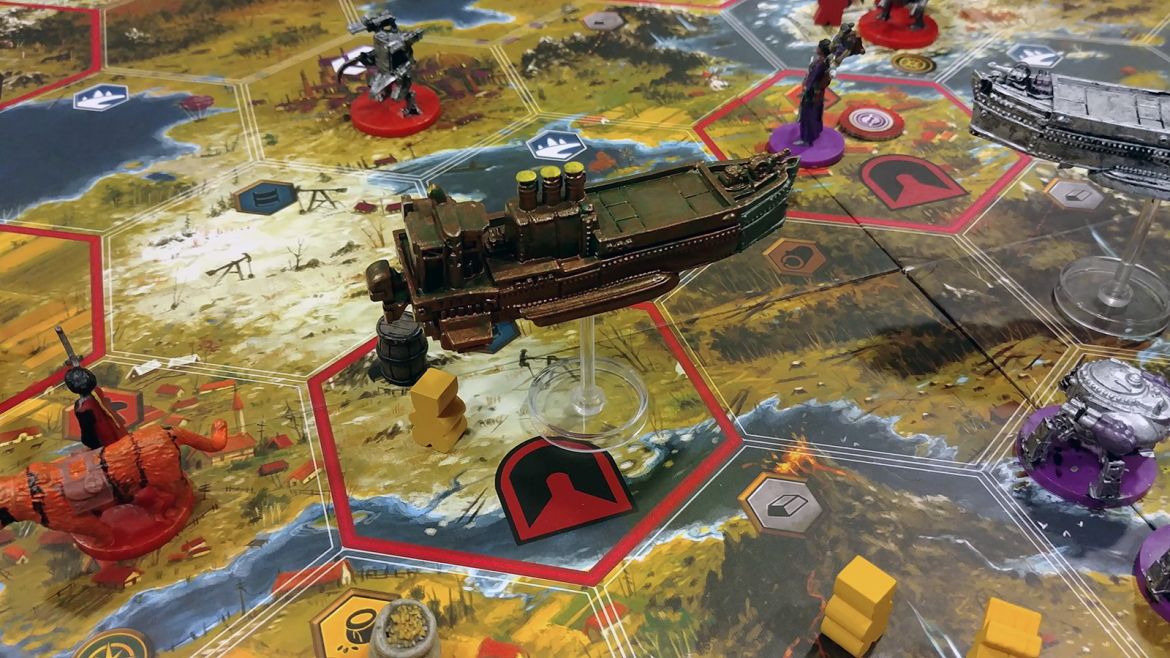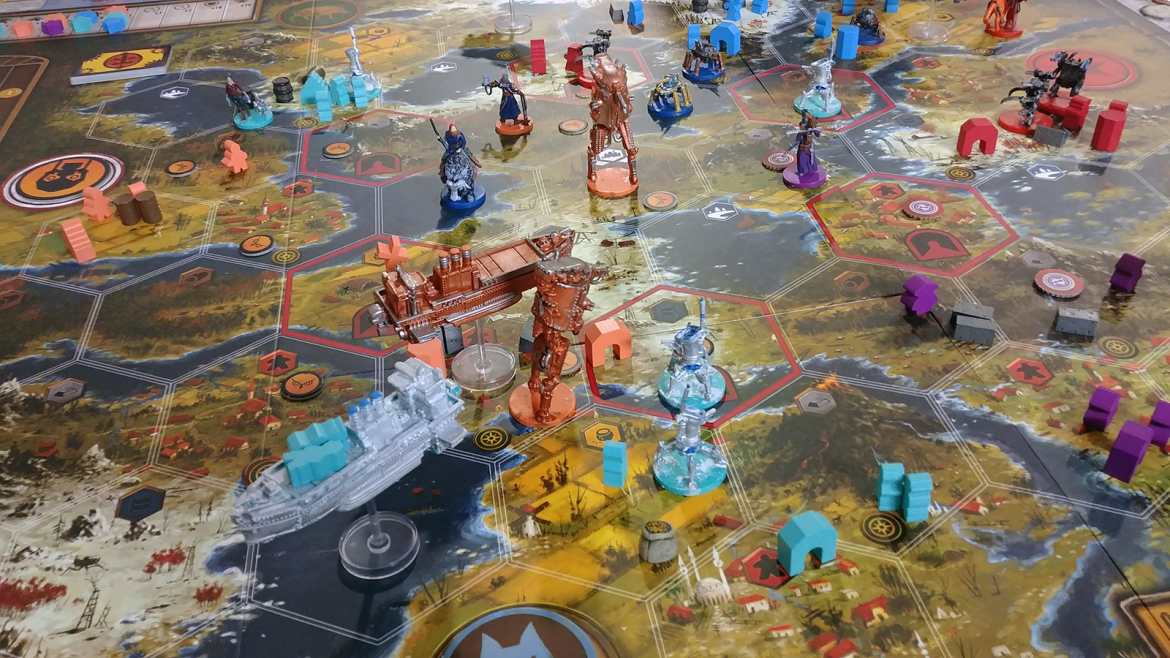In a previous blog post, I chatted about some elements commonly present in the legacy and campaign modes of board games, specifically the joy of the disposable cards found in Gloomhaven. Today, I’m going to critique a game that has a campaign mode which, although isn’t strictly legacy (there are no disposable elements and the entire game can be reset), co-opts a few features from the legacy approach. That game is Scythe, an engine-building board game that I recently played with some of the folks from the TAG Lab. I felt compelled to write about the game as, although I love continuity and persistence in board games, Scythe seems to actually be diminished by its campaign mode.
What Is Scythe?
When asked to describe exactly what Scythe is, my go-to summary is something along the lines of: “it’s like if Risk Legacy and Settlers of Catan had a steampunk baby.” While not entirely accurate – Scythe tends to be less combat oriented than the former and more luck-averse than the latter – many of the same strategies apply. Your general goals include controlling territory, producing resources, and improving your economic engine by constructing buildings and accumulating power and fame. It’s a pretty polished take on the engine-building genre, where a daunting array of mechanics become manageable through simple turn structures and repetition.

Set in a re-imagining of 1920s Europe, Scythe pits a collection nations against each other in economic and military warfare. The twist? Each nation possesses a cadre of giant steampunk robots and an enormous airship to aid their cause. Although having an arsenal of monstrous mechanoids at their disposal may lead players to believe that combat is the primary goal of Scythe, constant aggression is often a poor strategy. Open warfare can put an enormous strain on a player’s resources and, as we discovered during our campaign, “spite persists between matches.” You’ll almost always face retribution for your invasions in later matches.
Following in the footsteps of many other board games, Scythe features a campaign mode facilitated by a trio of expansions: Invaders from Afar, The Wind Gambit, and The Rise of Fenris. Each expansion allows a consistent playing group to progress through eight matches of Scythe, gradually unfolding the plot and adding new elements to the game. In this article, I am primarily concerned with The Rise of Fenris: the final entry in the expansion trilogy and the campaign that I have the most experience with.
Upsetting The Balance
While I am a huge fan of campaign style games in general – ranging from the relative simplicity of Risk Legacy to the uber depth of Gloomhaven – I feel like Scythe is one of the few iterations on the concept that actually loses some appeal through the addition of continuity. The reason for this is twofold – game balance and momentum.
The core balance issue in Scythe is that some of the factions are flat out stronger than others. I was lucky to enough to pick Crimea as my starting faction – statistically proven as the most potent among the core set – which resulted in me sweeping the first four matches. This was despite being a first-time player and, generally speaking, a mediocre strategy gamer. Unlike Risk Legacy, where factions are drafted at the beginning of each match, you’re generally committed to a nation for at least a few games. It also takes a while for players to get a feel for why a faction is overpowered, and how to effectively counter it, by which point someone may have already gone on a lengthy winning streak. The only reason I didn’t continue my reign of terror was due to the addition of a new potent (unlockable) faction joining the fray, and our collective decision to banish Crimea from the campaign.

These winning streaks may have been manageable if it weren’t for the momentum issues present within campaign continuity. Players are rewarded with currency after each match, with larger payouts based on individual performance. This currency can be exchanged for one-time bonuses (starting a match with a slight resource advantage, for example) or persistent “Mods” that allow you to accelerate the growth of your economic engine. Players who win a lot in the early phases of the game tend to have a huge leg-up on their competitors, quickly deploying mechs and gaining resources at the beginning of every match. By the mid-point of our campaign, many of our group lamented that they felt “left behind” and could not see a way to catch-up with the top two or three players. This was despite the fact that the campaign champion isn’t determined by aggregate wins: Rise of Fenris is instead decided by an exciting, all-or-nothing final match. Players who had a rough start in the early game were held back by the sluggishness of their engines – their lack of mods made it difficult for them to consistently trigger win conditions and reduced their ability to be major players in the final handful of matches.
When combined, these two problems can make the campaign a bit disheartening. Nothing is more frustrating than making a few bad decisions early on, then feeling like you have to pay for them for the rest of the campaign. This is especially exacerbated for new players, who may find themselves at a serious disadvantage by the time they’ve figured out how the game works.
Don’t Ditch The Game, Tweak The Campaign
Despite my grumblings on the failings of the game’s campaign mode, I actually enjoyed Scythe quite a lot. It can be a bit daunting at first glance – boasting an immense array of game pieces and player options – but it will eventually hook you with its varied gameplay, beautiful presentation, and relatively straightforward turn structure. Single matches are a joy, and some simple house rules (adjusted wealth distribution, drafting factions, etc) could go a long way toward turning a disappointing campaign into a highly competitive one. Plus, it’s hard to resist the allure of marching an army of giant robots across a hyper-stylized steampunk Europe.
